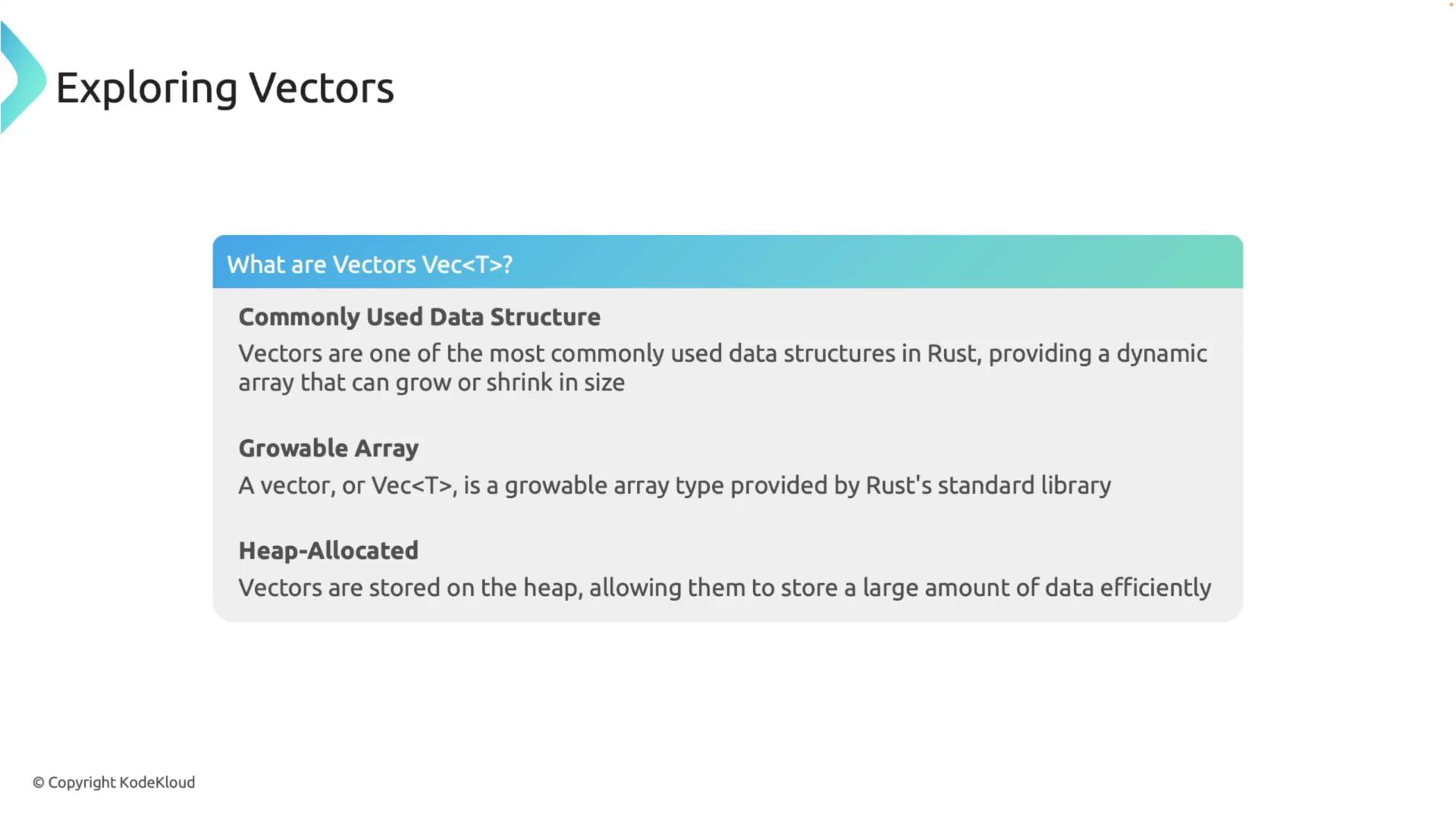Rust Programming
Collections Error Handling
Vectors
In this article, we dive into vectors in Rust—a versatile, dynamic array data structure that grows and shrinks as needed. Vectors are one of the most commonly used data structures in Rust since they provide efficient, heap-allocated storage for a variable amount of data. By the end of this article, you will understand how to create, update, iterate, and manipulate vectors in Rust while respecting its ownership and borrowing rules.

Creating Vectors
There are several ways to create vectors in Rust. One straightforward method is using the Vec::new() function to generate an empty vector and then adding elements with the push method:
fn main() {
let mut v: Vec<i32> = Vec::new(); // Creates an empty vector that can hold i32 values
v.push(1);
v.push(2);
v.push(3);
println!("{:?}", v); // Output: [1, 2, 3]
}
Alternatively, you can initialize a vector with predefined values using the vec! macro:
fn main() {
let v = vec![1, 2, 3];
println!("{:?}", v); // Output: [1, 2, 3]
}
Updating Vectors
Vectors are dynamic, allowing you to modify them using methods like push, pop, and insert:
- The
pushmethod appends an element to the end of the vector. - The
popmethod removes the last element and returns it (returningNoneif the vector is empty). - The
insertmethod adds an element at a specified index, shifting other elements to the right.
Examples
fn main() {
// Using push
let mut v = vec![1, 2, 3];
v.push(4);
println!("{:?}", v); // Output: [1, 2, 3, 4]
}
fn main() {
// Using pop
let mut v = vec![1, 2, 3, 4];
v.pop();
println!("{:?}", v); // Output: [1, 2, 3]
}
fn main() {
// Using insert
let mut v = vec![1, 2, 4];
v.insert(2, 3);
println!("{:?}", v); // Output: [1, 2, 3, 4]
}
When accessing elements by index, using an out-of-bound index will cause the program to panic. Instead, you can use the get method which returns an Option, allowing for safer access:
fn main() {
let v = vec![1, 2, 3];
// Accessing using indexing (may panic if out of bounds)
let third: &i32 = &v[2];
println!("The third element is {}", third); // Output: The third element is 3
}
fn main() {
let v = vec![1, 2, 3];
// Accessing using get (returns Some if within bounds, otherwise None)
match v.get(2) {
Some(third) => println!("The third element is {}", third),
None => println!("There is no third element."),
}
}
Iterating Over Vectors
There are various ways to iterate through a vector. You can use a simple for loop to iterate by reference:
fn main() {
let v = vec![1, 2, 3];
for i in &v {
println!("{},", i);
}
}
Alternatively, use the iter method to obtain an iterator over references to the elements:
fn main() {
let v = vec![1, 2, 3];
for i in v.iter() {
println!("{}", i);
}
}
If you need to modify each element while iterating, use mutable references:
fn main() {
let mut v = vec![1, 2, 3];
for i in &mut v {
*i += 1;
}
println!("{:?}", v); // Output: [2, 3, 4]
}
Common Vector Methods
Length and Empty Check
You can check the size and emptiness of a vector with the len and is_empty methods:
fn main() {
let v = vec![1, 2, 3];
println!("Length of the vector: {}", v.len());
}
fn main() {
let v: Vec<i32> = Vec::new();
println!("Is the vector empty? {}", v.is_empty()); // Output: true
}
Checking for an Element
To verify if a vector contains a specific element, use the contains method:
fn main() {
let v = vec![1, 2, 3];
println!("Does the vector contain 2? {}", v.contains(&2)); // Output: true
}
Removing Elements
Remove an element at a specific index with the remove method, which also returns the removed element:
fn main() {
let mut v = vec![1, 2, 3, 4];
let removed = v.remove(2);
println!("Removed element: {}", removed); // Output: 3
println!("Vector after removal: {:?}", v); // Output: [1, 2, 4]
}
Extending a Vector
Append elements from any iterator to the end of a vector using the extend method:
fn main() {
let mut v = vec![1, 2, 3];
v.extend(vec![4, 5, 6]);
println!("{:?}", v); // Output: [1, 2, 3, 4, 5, 6]
}
Ownership and Borrowing
Rust’s ownership and borrowing rules apply to vectors too. When a vector is assigned to a new variable, ownership is transferred (moved), and the original variable becomes invalid. For instance:
fn main() {
let v = vec![1, 2, 3];
let v2 = v; // Moves v to v2
// println!("{:?}", v); // Uncommenting this line will cause a compile-time error as v is no longer valid
println!("{:?}", v2); // Output: [1, 2, 3]
}
To work with vectors without transferring ownership, borrow the vector or its elements using references:
fn main() {
let v = vec![1, 2, 3];
let first = &v[0]; // Borrowing the first element
println!("The first element is {}", first); // Output: 1
println!("The vector is {:?}", v); // Output: [1, 2, 3]
}
Borrowing an Entire Vector in a Function
When passing a vector to a function without transferring ownership, use a reference parameter. This way, the original vector remains valid after the function call:
fn print_vector(v: &Vec<i32>) {
println!("The vector is: {:?}", v);
}
fn main() {
let v = vec![10, 20, 30, 40];
// Borrow the entire vector
print_vector(&v);
// The original vector is still accessible
println!("The original vector is still accessible: {:?}", v);
}
Note
Understanding Rust's ownership and borrowing model is crucial when working with vectors. It helps prevent common bugs related to memory safety.
This concludes our exploration of vectors in Rust. By mastering the creation, updating, iteration, and manipulation of vectors—and by understanding Rust’s ownership and borrowing rules—you can unlock the full potential of this flexible data structure in your Rust programs.
Further Reading
Watch Video
Watch video content